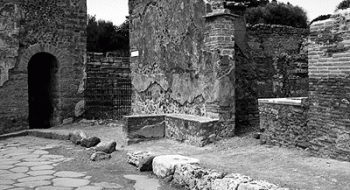American Journal of Archaeology | The Journal of the Archaeological Institute of America
You are here
Si quis hic sederit: Streetside Benches and Urban Society in Pompeii
January 2008 (112.1)
Si quis hic sederit: Streetside Benches and Urban Society in Pompeii
Built by individual initiative but open to use by city dwellers, Pompeii’s 100 streetside benches stood at a pivot point, forming part of the architectural interface between interior, privately financed architecture and the exterior space of the street’s public domain. Like many elements of Roman cities, benches have been examined primarily from their builders’ viewpoint and within one setting (the elite house and the salutatio). This multiperspective case study calls for a more complex understanding of how and why architectural features were built (or not) along Roman streets. Investigation through aesthetic, legal, and sociohistorical lenses demonstrates that benches—located in front of shops, bars, and houses large and small—were an important part of their owners’ streetward presentation, and aided in visually organizing facades and drawing favorable attention from passersby. A quantitative and spatial analysis of benches shows that builders sought out busy and impressive settings for these constructions. It also reveals that the public exerted pressure against bench building where traffic would be obstructed, and expressed favor for bench building in shady spots. The study of streetside benches thus holds potential for understanding the negotiation of individual and public desires in Roman urban society, for thinking not just about the owner-centric insides of buildings or the chaotic outsides but also about the push and pull between those two spheres.
Si quis hic sederit: Streetside Benches and Urban Society in Pompeii
By Jeremy Hartnett
American Journal of Archaeology Vol. 112, No. 1 (January 2008), pp. 91–119
DOI: 10.3764/aja.112.1.91
© 2008 Archaeological Institute of America


